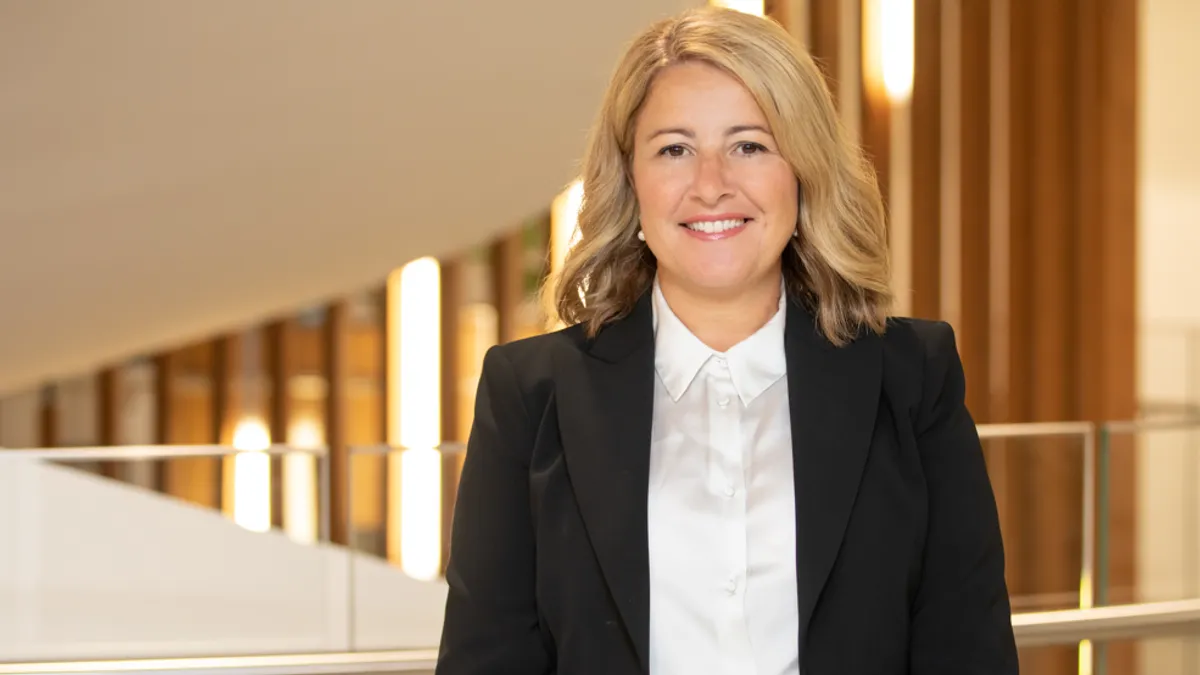This article is one in a series of conversations with women leaders in the construction industry. Click here for past discussions.
As a leader of one of the country’s top construction firms, Lara Poloni has helped plan, assess and develop major infrastructure projects all over the world.
Having risen from urban planner to become president of Dallas-based construction giant AECOM during her nearly 30-year career, Poloni has witnessed major shifts in how contractors design, manage and build projects, including increased emphasis on sustainability, technology, resiliency and diversity.
“At AECOM, we’ve long recognized the importance of our teams reflecting the communities we serve and, like the broader sector, have seen encouraging progress in driving equity, diversity and inclusion across our global business,” she said. “What excites me most is seeing the benefits of this focus through our people and what we’re able to deliver for our clients.”
Here, Poloni talks with Construction Dive about this historic time for U.S. infrastructure, how the industry has changed over the last three decades and what is still needed to make it more inclusive.
Responses have been edited for brevity and clarity.
CONSTRUCTION DIVE: What interested you about construction as a career choice?
LARA POLONI: A career in infrastructure provides a world of opportunity. Even as a student, I always had a keen interest in cities and what makes them liveable, and, by extension, the infrastructure that serves them and the social and environmental factors that shape them. Few other fields offer the chance to see your work come to life so tangibly and its impact to be so broadly felt.
Early in my career, I saw the power and potential of our industry to change lives. The design of a bike or pedestrian path, the development of a new suburban rail station, the layout of a building, the expansion of a major commercial port — all might seem relatively basic, but their impact in improving accessibility, movement of goods and quality of life can’t be understated. As I progressed in my career, I realized these are all very interconnected parts of a city’s ecosystem.
The ability to shape stronger, more liveable communities was what drew me to my early roles in planning, and it’s what still excites me today as president of AECOM.
What do you most enjoy about your job?
The same things interest me today as when I was starting out — being part of a team with the industry’s best technical leaders. Working alongside many of these leaders taught me so much during my career and I still love hearing about our technical innovations — how they help us win, help our clients with their mission and most importantly deliver great outcomes for the communities we serve.
Our employees’ passion for what they do — whether that’s designing and delivering high-speed rail systems, conducting archeological surveys or building out clean energy infrastructure — is what led them to AECOM, it’s something you feel in the many conversations we have. It’s what makes working at AECOM such a rewarding experience — and why I’ve spent my career here.
AECOM’s strategy is Think and Act Globally, and it speaks to the ability we have, as a global organization, to leverage our size, scale and the industry’s best technical professionals to deliver infrastructure solutions. This really comes to life at the local level when I think of projects like the Fair Park Dallas modernization and program management for DFW International Airport where we’re developing the next generation of infrastructure for the Dallas-Fort Worth metroplex.
I think it’s this local focus that really set us apart as a global firm and makes our work so rewarding. No matter the location, our teams make immense contributions to improving their communities, whether that’s the California High Speed Rail here in the United States, HS2 in the United Kingdom, AlUla in Saudi Arabia or the Western Harbour Tunnel in Australia.
How has the role of women in construction changed over the course of your career?
The industry I joined 30 years ago is almost unrecognizable today. We’ve made good, hard-won progress in creating a more diverse industry, and a more inclusive mindset, but we still have more work to do.
When I reflect on my early career, recognition of women was limited, and that wasn’t just because there were so few women to recognize. It was disheartening to see how few women held leadership roles and, frankly, it was also a waste. So much amazing talent was left underutilized. Today, that’s changed to an extent.
While women are being acknowledged for their many contributions, from leading megaprojects to running entire firms, the historical gender imbalance does persist. While the industry culture is changing, more progress must continue.
Part of that change must be about more than gender. Respect for diversity in all its forms — race, nationality, sexuality, age and so many other identities — defines inclusion and shapes equity. For the next generation of infrastructure to be equitable and sustainable, we can’t afford to ignore the diversity. Instead, we must embed as many perspectives as possible into our work. That will be essential to our success.
What advice would you give to young women considering construction as a career?
I am asked this question often, and I always encourage women, regardless of their career level, to back themselves and to start with saying “yes” to opportunities when they arise, even when it’s daunting and the immediate reaction is to say “no.” I also tell them that they need to take control of their career, like they would manage a project.
There are more opportunities for women within our industry today than there ever have been. Saying yes is accumulative. It shapes a mindset that overcomes adversity, and it’s this mindset that generates progress.























